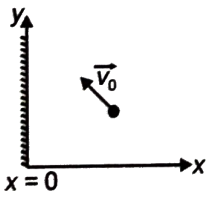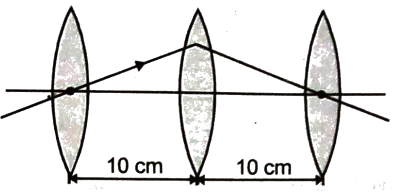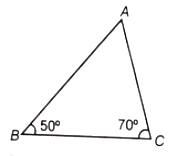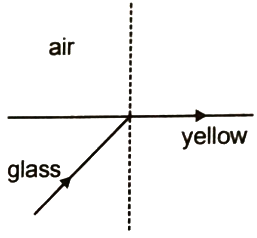| 1. | \(45\) cm | 2. | \(30\) cm |
| 3. | \(15\) cm | 4. | \(25\) cm |
A boy with defective eye-sight cannot see things beyond 50 cm. The corrective lens required has the power:
1. +1 D
2. +2 D
3. -1 D
4. -2 D
Two objects are placed at a distance of 100 m from a person. The diameter of the eye-lens of the person is 2 mm. What should be the separation between the objects so that they can be seen just resolved? (The wavelength of light is 5000 )
1. 1 cm
2. 1.5 cm
3. 2 cm
4. 3 cm
The near point of a hypermetropic eye is \(1~\text{m}.\)What is the power of the lens required to correct this defect?
1. \(-3~\text{D}\)
2. \(+3~\text{D}\)
3. \(+1~\text{D}\)
4. \(-1.75~\text{D}\)
The following diagram shows a glass sphere of radius 10 cm with a paraxial incident ray. The refractive index of the material of the glass is
1. 2
2. 1.5
3. 1.75
4. 1.3
A convex lens forms the image of a point object \(O\) on the screen. If a glass slab of thickness 3 cm and refractive index 1.5 is put as shown below, then to have the image of the object on the screen, the object should be shifted:
| 1. | away from the lens by 1 cm |
| 2. | away from the lens by 1.5 cm |
| 3. | towards the lens by 1 cm |
| 4. | towards the lens by 1.5 cm |
| 1. | \(60~\text{cm}\) | 2. | \(120~\text{cm}\) |
| 3. | \(30~\text{cm}\) | 4. | \(180~\text{cm}\) |
A plane mirror is fixed in YZ-plane at x = 0. The velocity of a moving object is . The velocity of the image relative to a stationary observer will be:
1.
2.
3.
4.
Three identical thin convex lenses are kept as shown in the figure. A ray passing through the lenses is shown. The focal length of each lens is 
1. 5 cm
2. 10 cm
3. 15 cm
4. 20 cm
If light ray is incident normally on face AB of a part of a prism, then for no emergent ray from second face AC [refractive index of glass of prism]
(1)
(2)
(3)
(4) can have any value
| Assertion (A): | The nature of the image of an object depends on the size of the mirror. |
| Reason (R): | It is not possible to obtain a real image by a plane mirror. |
| 1. | Both (A) and (R) are True and (R) is the correct explanation of (A). |
| 2. | Both (A) and (R) are True but (R) is not the correct explanation of (A). |
| 3. | (A) is True but (R) is False. |
| 4. | Both (A) and (R) are False. |
The focal length of an equiconvex glass lens() in air is 20 cm. The relative refractive index of glass with respect to water is . If the lens is dipped in water, then its new focal length in water is-
1. 20 cm
2. -20 cm
3. 80 cm
4. -80 cm
| 1. | \(X+Y\) | 2. | \(\dfrac{X +Y}{2}\) |
| 3. | \(X-Y\) | 4. | \(\dfrac{X -Y}{2}\) |
A light beam containing red, yellow and blue color, falls on the interface of glass-air as
shown. If the yellow light is just totally internally reflected then emergent ray in air contain
1. Both red and blue color
2. Only red color
3. Only blue color
4. No color